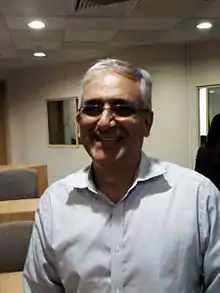Arun Rai
Arun Rai (born 1963) is an Indian born American scientist. Arun Rai is permanet Regents' Professor at the Robinson College of Business at Georgia State University and holds the J. Mack Robinson Chair of IT-Enabled Process Innovation and Supply Chains and the Harkins Chair of Information Systems. He served as the editor-in-chief of Management Information Systems Quarterly (MISQ) for five years between 2016 and 2020.[1][2] He has previously served as Senior Editor for Information Systems Research, MIS Quarterly, and Journal of Strategic Information Systems and as Associate Editor for several journals (e.g., Journal of Management Information Systems, Management Science, Decision Sciences, IEEE Transactions on Engineering Management, Information Systems Research, MIS Quarterly and Journal of the Association for Information Systems).

Education and Employment
Arun Rai earned his integrated master's degrees in science and technology from BITS Pilani in 1985, MBA from Clarion University of Pennsylvania in 1987, and PhD in Management Information Systems from Kent State University in 1990. He served as an assistant and later as an associate professor at Southern Illinois University at Carbondale from 1990 until 1997 before moving to Georgia State University in 1997. He has chaired 30 doctoral dissertations as of 2019.[3]
Awards and Recognitions
Arun Rai is one of the most prolific authors for MIS Quarterly.[4]
In recognition of his significant global contributions to the scientific research in the field of Information Systems, Rai was recognized as the Fellow of Association of Information Systems (FAIS) in 2010.[5]
Rai was awarded with the Information Systems Society (ISS) Distinguished Fellow in 2014.[6]
Arun Rai was the recipient of the prestigious LEO award (awarded in 2019 in Munich), which is named for the world's first business application of computing (The Lyons Electronic Office), and recognizes truly outstanding individuals in the field of Information Systems.[7][8]
References
- "Arun Rai Named Next Editor-in-Chief of MIS Quarterly - Robinson College of Business". robinson.gsu.edu. Retrieved 2016-01-15.
- "Editorial Board". misq.org. Retrieved 2017-11-17.
- "Arun Rai" (PDF).
- "MIS Quarterly's Prolific Authors" (PDF).
- "AIS Fellow Award".
- "ISS Award".
- "AIS LEO Awards".
- "MetroAtlantaArun".